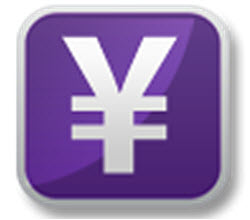The Japanese yen (¥) has been the official currency of Japan since its introduction in 1871. It is currently the third most traded currency on the forex market, behind USD and EUR. The Japanese yen is sold freely on forex markets around the world and has a fluctuation value vis-à-vis other currencies.
 The Japanese yen (JPY) is widely used reserve currency, although not quite as popular as the USD, EUR and GBP. These four currencies make up the currency basket used by the International Monetary Fund (IMF) to calculate the value of IMF:s special drawing rights.
The Japanese yen (JPY) is widely used reserve currency, although not quite as popular as the USD, EUR and GBP. These four currencies make up the currency basket used by the International Monetary Fund (IMF) to calculate the value of IMF:s special drawing rights.
Curry trade has helped keep the value of the yen down against other major currencies, a situation appreciated by Japanese export companies. Low Japanese interest rates and the high liquidity of the yen has served to make curry trade – where an investor borrows money in one country (Japan) and invest them in another – a lucrative endeavor with a vast potential upside.
Facts about the Japanese yen
- The central bank for the Japanese yen is Nippon ginkō.
- The Japanese sign for this currency is 円.
- The ISO-4217 currency code for the Japanese yen is JPY.
- The symbol ¥ denotes the Japanese yen.
- When the Japanese yen was introduced in 1871, a gold standard was put into to law for the currency. This gold standard has since been removed and the money is now fiat money.
- 1 yen consists of 100 sen. 1 sen consists of 10 rin. There are no rin or sen coins / bills in circulation, since they were withdrawn as early as 1954.
- The y is silent. The name of this currency is thus correctly pronounced as “en” rather than “yen” or “jen”.
- Just like the Chinese yuán and the Korean won, the Japanese yen means round or circular. When Spanish and Mexican silver coins reached this part of the world, they had a round shape and this is how they got their local names. Round coins did not exist in Japan before those days, and silver objects of any shape was used for trade. When Japan eventually begun making their own standardized round coins, they used the name yen for them as well.
Monetary policy of the Japanese central bank
As mentioned above, the Japanese yen had a gold standard when it was launched in 1871. 60 years later, Japan embarked on a journey where they gradually removed the gold standard and turned the Japanese money into fiat money.
During the 1985 – 1995 period, the yen went through a remarkable value increase in relation to most major currencies. For the year 1985, 1 USD would (on average) give you roughly 240 yen. In April 1995, 1 USD would give you no more than 80 yen.
So, what’s the situation today? After the burst of a real estate and stock bubble in Japan, the yen commenced a rapid descent. By February 2002, 1 USD was worth 134 yen. Then, the financial crisis of 2007-2008 hit the global markets and the yen ascended in relation to most other currencies, with the Swiss franc being one notable exception.
Since the 1990’s, the central bank of Japan (Nippon ginkō) has kept the interest rates low in an effort to promote economic growth. In 1993, the short term interest rate was 3.7 percent. 15 years later, it had sunk to just 1.3 percent.
Even though the Nippon ginkō has kept the interest rates low to stimulate growth, they have been under fire from the Japanese government for not doing enough to act against the deflation. Many times, the central bank has turned down requests from the government to further stimulate the Japanese economy. (In 1997, a major law change took place in Japan which resulted in a high degree of autonomy for the Nippon ginkō.)
It should be mentioned however that with Shinzō Abe as premier minister, the Nippon ginkō has become more keen to actively increase the amount of money in circulation by making substantial bond purchases as well as buying other financial instruments for considerable amounts of money. In April 2013, Nippon ginkō announced that they would expand their program further by making purchases for the equivalent of $1.4 trillion USD during a two year period. The aim was to bring Japan out of deflation and into a 2 percent inflation.
